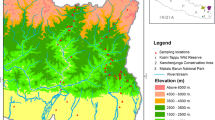Abstract
Forty-one amphibian habitats of various types in northern Israel were examined, in which water availability ranged from one month in the year to all year round. Larvae of all six species of amphibians native to the region, Salamandra salamandra, Triturus vittatus (Urodela), Hyla arborea, Bufo viridis, Rana ridibunda and Pelobates syriacus (Anura), were studied. The distribution of the species was governed by biotic and abiotic factors in the habitats, but not by the type of water body. Thus, larvae of all six species were found in temporary winter ponds, but only Salamandra and Bufo in streams and springs during the winter, and Rana during the summer. Ambient temperature, duration of water availability and elevation of the water body were major factors in species distribution. Species distribution also varied according to season. Species diversity increased from winter to summer. The growth rate of small larvae was found to be slower than that of larger larvae.
Similar content being viewed by others
References
Blaustein, L. & J. Margalit, 1994. Mosquito larvae (Culiseta longiareolata) prey upon and compete with toad tadpoles (Bufo viridis). J. anim. Ecol. 63: 841–850.
Blaustein, L. & J. Margalit, 1996. Priority effects in temporary ponds: nature and outcome of mosquito larva-toad interaction depends on order of entrance. J. anim. Ecol. 65: 77–84.
Blaustein, L., J. Friedman, T. Fahima, M. Warburg & 1996. Larval Salamandra drive temporary pool community dynamics: evidence from an artificial pool experiment. Oikos 76: 392–402.
Borgens, R. B., M. E. McGinnis, J. W. Vanable, Jr. & E. S. Miles, 1984. Stump currents in regenerating salamanders and newts. Exp. Zool. 231: 249–256.
Clarke, B. T. 1997. The natural history of amphibian skin secretions, their normal functioning and potential medical applications. Biol. Rev. Camb. Philos. Soc. 72: 365–379.
Degani, G., 1981, The adaptation of Salamandra salamandra (L.) from different habitats to terrestrial life. Brit. J. Herpetol. 6: 169–172.
Degani, G., 1982. Amphibian tadpole interaction in winter pond. Hydrobiol. 96: 3–7.
Degani, G., 1986. Growth and behavior of six species of amphibian larvae in winter pond in Israel. Hydrobiol. 140: 5–10.
Degani, G., 1993. Cannibalism among Salamandra salamandra (L.) larvae. Israel J. Zool. 39: 125–129.
Degani, G., 1996. The Salamander at the Southern Limit of its Distribution. Laser Pages Publ. Ltd. Jerusalem, Israel: 154 pp.
Degani, G., & H. Mendelssohn, 1979. The food ofSalamandra salamandra (L) tadpoles in Israel in different habitats. Proc. X Sci. Conf. Israel Ecological Soc: 19–45.
Degani, G. & H. Mendelssohn, 1983a. The habitats, distribution and life history of Triturus vittatus vittatus (Jenyns) in the Mount Meron Area (Upper Galilee, Israel). Brit. J. Herpetol. 6: 317–319.
Degani, G. & H. Mendelssohn, 1983b. Seasonal activity of Salamandra salamandra (L.) (Amphibia, Urodela) in headwaters of the Jordan river. Israel J. Zool. 31: 77–85.
Katz, U., G. Degani & S. Gabbay, 1984. Acclimation of the euryhaline toad Bufo viridis to hyperosmotic solution (NaCl, Urea, and Mannitol). J. Exp. Biol. 108: 403–409.
Lefcort, H., R. A. Maguire, L. H Wilson & W. F. Ettinger, 1998. Heavy metals after the survival, growth, metamorphosis and antipredatory behavior of Columbia spotted frog (Rana luteiventris) tadpoles. Arch. Environ. Contam. Toxicol. 35: 447–456.
Mineta, T., T. Inikuchi, K. Kobayashi & S. Horiuchi, 1998. Distribution of cathepsin E in the larval and adult organs of the bullfrog with special reference to the mature form in the larval fore-gut. Comp. Biochem. Physiol. 121(3): 333–340.
Ouellet, M., J. Bonin, J. Rodrigue, J. L. DesGranges & S. Lair, 1997. Hindlimb deformities (ectromelia, ectodactryly) in freeliving anurians from agricultural habitats. Wildl. Dis. 33: 95–104.
Parker, R. E., 1986. Introduction to Statistics for Biology. Edwin Arnold, London: 26–28.
Pavignano, I., 1990. Niche overlap in tadpole populations of Pelobates fuscusinsubricus and Hyla arborea at a pond in north western Italy. Boll. Zool. 57: 83–87.
Skriver, P., 1988. A pond restoration project and a tree-frog (Hyla arborea) project in the municipality. Mem. Soc. Fauna-Flora Fen. 64(3): 146–147.
Steward, J. W., 1969. The Tailed Amphibians of Europe. David & Charles, Plymouth, U.K., 190 pp.
Warburg, M. R., 1988. Adaptation of amphibians to life in xeric habitats. In Ghosh, P. K. & I. Prakash (eds), Ecophysiology of Desert Vertebrates. Scientific Publ., Jodhpur, India: 59–98.
Warburg, M. R., 1993. Long-term studies on population structure and reproductive strategies in a Salamandra salamandra population on Mt. Carmel. Israel J. Zool. 39: 77.
Warburg, M. R., 1997. Ecophysiology of Amphibians Inhabiting Xeric Habitats. Springer Verlag, Berlin: 179 pp.
Warburg, M. R. & M. Rosenberg, 1990. Ion and water balance and their endocrine control in the aquatic amphibians. Fort. Zool. 38: 385–403.
Warburg, M. R., G. Degani & I. Warburg, 1979. Growth and population structure of Salamandra salamandra (L.) larvae in different limnological conditions. Hydrobiol. 64: 147–155.
Warkentin, K. M., 1992. Microhabitat use and feeding rate variation in green frog tadpoles (Rana clamitans). Copeia 3: 731–740.
Wassersug, R. J. & D. B. Wake, 1995. Fossil tadpoles from the Miocene of Turkey. Alytes 12(4): 145–157.
Wilbur, H. M., 1987. Regulation of structure in complex systems: Experimental temporary pond communities. Ecology 68: 1437–1452.




